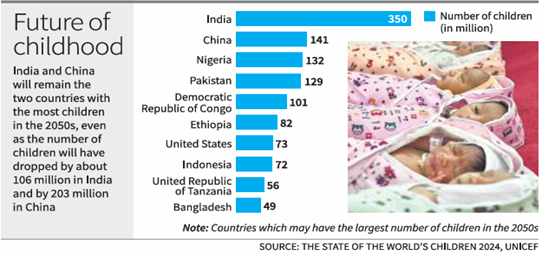
- The SOWC-2024 report warns of an unprecedented planetary crisis affecting nearly half of the world’s children (one billion), living in countries facing high risks of climate and environmental hazards.
- It examines the impacts of 3 long-term global forces that will profoundly shape children’s lives until 2050.
- Climate and environmental crises
- Demographic shifts
- Frontier technologies
- Climate and Environmental Crises:
- Children’s developing bodies are highly susceptible to air pollution, extreme weather, and waterborne diseases.
- Pollution harms respiratory health; rising temperatures spread vector-borne diseases like malaria and dengue.
- Floods contaminate water supplies; extreme weather reduces food production, increasing malnutrition risks.
- Climate-related disasters lead to trauma, anxiety, and feelings of helplessness among children.
- Since 2022, 400 million students faced school closures due to extreme weather, affecting learning and economic growth.
- Climate hazards are a significant driver of child displacement.
- Demographic Shifts:
- By 2050, the global child population is expected to stabilize at 2.3 billion, with significant regional disparities.
- South Asia, eastern and southern Africa, and western and Central Africa will host the largest child populations.
- These regions face significant climate risks, underdeveloped digital infrastructure, and struggles to meet basic needs.
- Frontier Technologies:
- Artificial intelligence, neurotechnology, renewable energy, and vaccine breakthroughs could transform childhood.
- While empowering, it exposes children to online risks like sexual exploitation.
- 95% of people in high-income countries are connected to the Internet compared to 26% in low-income nations.
Dig Deeper: Read about proactive measures by the Government of India for the Welfare of Children e.g. POCSO Act.

